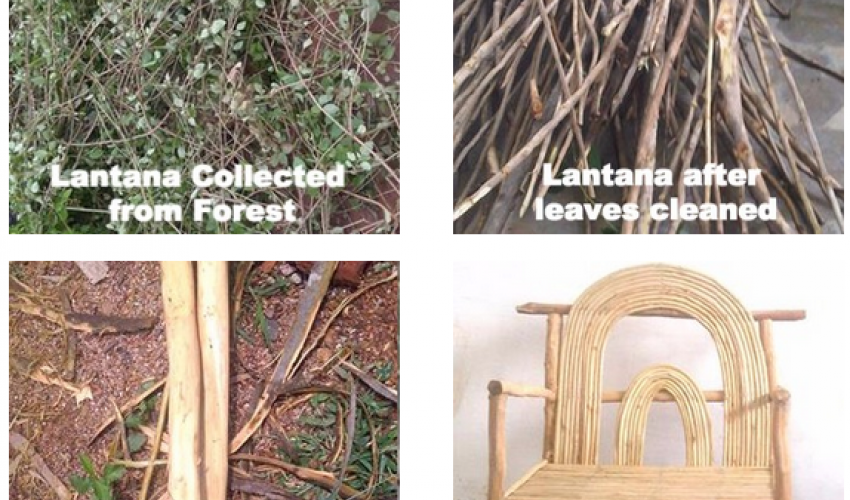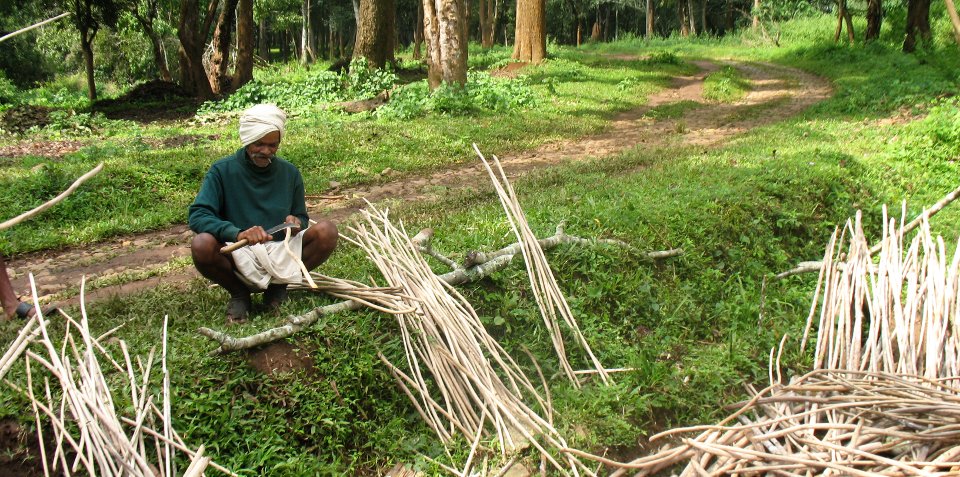Bengaluru Scientists Are Making Eco-Friendly Wood Polymer Composites from a Deadly Invasive Weed
Not only will this novel idea control the growth of an extremely invasive and toxic weed, it will create a sustainable source of income too.

“Each problem has hidden in it an opportunity so powerful that it literally dwarfs the problem. The greatest success stories were created by people who recognised a problem and turned it into an opportunity.” – Joseph Sugarman
One of the world’s most invasive weed, Lantana camara, has been plaguing forest ecosystems across India for years.
In a novel solution to this problem, scientists from the Bengaluru-based Institute of Wood Science & Technology (IWST) have developed a plan that kills not two, but three birds with one stone.

By using Lantana wood to produce wood polymer composites (WPC), the IWST scientists want to weed out this toxic invasive plant, enhance the country’s production of wood composites and prevent carbon from escaping into the atmosphere (which is what happens when this weed is burnt as waste).
Brought as an ornamental shrub from South America to India in 1809, Lantana has rapidly become a threat to biodiversity in India’s forests, agricultural lands, and pasture lands.

Photo Source
A rapidly growing weed, Lantana covers open ground very quickly. These fiercely competitive plants release chemicals that inhibit/stunt the growth of other plants. This adversely impacts the productivity of the soil and eliminates important native plant species, leading to a reduction in the biodiversity of the region. As its leaves and flowers are toxic, Lantana also leads to the migration or decline in the number of herbivores in the area. This can lead to starvation of tigers, lions, and other carnivores at the top of the food chain. The weed is also considered a potential fire hazard in deciduous forests as it is combustible even when green.
In short, the voracious growth of Lantana is threatening the population of big cats, the biodiversity of native flora and fauna as well as causing serious livelihood problems for farmers, livestock herders and forest dwellers. That is why IWST has been working to find economically viable and sustainable ways of controlling, if not eradicating, this plant.
With this in mind, IWST has recently developed a wood polymer composite by using nanotechnology to mix Lantana wood and plastic. This is a laudable scientific achievement as wood and plastic are generally considered to be like water and oil – impossible to combine.
This low-maintenance composite may not be as cheap as wood but once the market for this new product grows, the prices should come down too.

Photo Source Left / Right
Called green composites, WPCs are a group of innovative materials made from wood fibres, thermoplastics and biopolymers. In addition to using recycled materials and being potentially biodegradable, WPC’s can also be recycled themselves.
These composites can be used as cost-effective and eco-friendly alternatives for a variety of applications – from the construction of window frames, doors, and decks to making household items like furniture and foot mats.

Photo Source
India currently lags in WPC production, while China is leading the world in its production (China produced 18 lakh tonnes in 2015 compared to India’s 70,000). Even the low tonnage of WPCs produced in India is made from materials imported from other countries.
To encourage the indigenous manufacture of WPC products, the IWST is planning to set up a WPC Research and Training Centre on its campus in Bengaluru that will use its new Lantana-WPC technology. Apart from the weed, IWST scientists are also exploring the potential of several other fibres, such as areca nut, coconut and coir, to make polymer composites.
In an interview to Bangalore Mirror, Director of IWST, Surendra Kumar said,
“In one go, we are trying to achieve the conditions of ‘Make in India’ as well as ‘Swachch Bharat Abhiyan’ as toilets in rural areas can be quickly assembled on site using WPC that is indigenously manufactured.”
Every year, the Forest Department cuts down tonnes of Lantana weed and just burns them down but the speed of regeneration of the weed surpasses the speed of its uprooting. The IWST scientists are now working with the forest departments of Karnataka, Tamil Nadu and Punjab to tackle this menace. According to these scientists, since the weed grows prolifically in India, there is very little cost or problem involved in growing and availing it to make the wood polymer composites.
There is another organization that is exploring this opportunity in a unique way as well. An NGO, The Shola Trust, has started an initiative that encourages local adivasi communities living in the Mudumalai Tiger Reserve to use Lantana wood to make furniture.

Photo Source
The waste pieces left behind are burned with other biomass to form charcoal, which in turn helps in sequestering carbon. This sustainable income generating activity is a great step that not only deals with the invasive plant but also combats climate change.
The Shola Trust provides marketing and design inputs to the adivasis and they have been joined in their efforts by the Tamil Nadu Forest Department, the Adivasi Munnetra Sangam and various Mudumalai Eco-Development Committees.
Whether it is cutting edge scientific technology or traditional tribal skill that is being used, both these initiatives have the potential of not only being very effective in controlling the growth of this extremely invasive, fast-spreading and poisonous weed but also putting it to good use. By recognizing the functional role of this species and managing it accordingly, these initiatives are truly turning adversity into an opportunity.
Also Read: Indian-Origin Scientists Create Nanoparticle Fertiliser, Usher in New Age of Farming
Like this story? Have something to share? Email: [email protected], or join us on Facebook and Twitter (@thebetterindia). To get positive news on WhatsApp, just send ‘Start’ to 090 2900 3600 via WhatsApp.
If you found our stories insightful, informative, or even just enjoyable, we invite you to consider making a voluntary payment to support the work we do at The Better India. Your contribution helps us continue producing quality content that educates, inspires, and drives positive change.
Choose one of the payment options below for your contribution-
By paying for the stories you value, you directly contribute to sustaining our efforts focused on making a difference in the world. Together, let’s ensure that impactful stories continue to be told and shared, enriching lives and communities alike.
Thank you for your support. Here are some frequently asked questions you might find helpful to know why you are contributing?


This story made me
-
97
-
121
-
89
-
167













